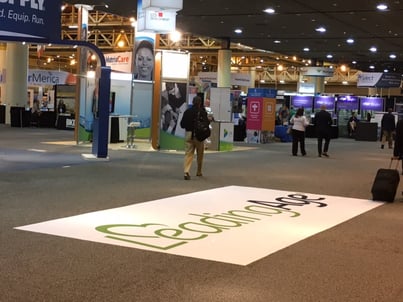I talked with a lot of folks at the 2017 LeadingAge Expo last week about how they can make the most out of their senior living community fitness center. In case you and I didn't connect at that event, here are 3 tips on how to make the most out of your community fitness center programs.
Start with the staff
Upgrading what you're offering in your fitness program is a great way to stand out from the competition (if you do it well), but offering a trainer a few hours per week likely isn't enough to truly draw residents into the fitness program.
If you have no staff - start there. Let's talk about how you can start providing expert staff in a cost effective manner with the greatest impact for your community.
If you have staff - evaluate how effective they are for your residents. There's a nuance here that's worth mentioning: how well-liked the staff are is not the same thing as how effective they are. Your residents deserve both an affable fitness team and effective, fun, engaging programs and services. So when you're thinking about how well your fitness staff are performing, start by addressing how well-received they are, but don't stop there. Ask how they spend their time in service to the residents and how are they measuring the success of the community fitness program. For example, are they providing services, like exercise prescriptions, equipment orientations, and assessments that help residents understand how to exercise safely while working positively toward their goals? Do you have data on how those services are used?
[Read More: How NIFS managers spend their time in senior living fitness centers]
Consider the programming
Fitness programming in the community goes well beyond fee-based personal training and group fitness classes. Many communities do robust programming exceptionally well. If your struggling with ideas, here are a few blogs that spotlight NIFS work with our clients in this area:
- Senior living community has a blast raising money for Alzheimer's Disease
- Using the fitness freeze to keep visit numbers up
- How we engage residents in fitness programs
As a leader in the community, you should be getting data about how effective the programming is, how many residents are participating, and what the fitness staff will do differently next time to achieve their goals. If you aren't getting that kind of information from your program, it might be time to look at ways you can improve your program.
Seek opportunities to improve
I talked with a number of community leaders who noted that they have fantastic staff in their fitness center and were thus certain that we wouldn't have services that would benefit their community. The truth is, there are always ways to do better; what we're really talking about here is whether there's an appetite to pursue improvement.
If you don't want to turnover staff, but you recognize your fitness team is only as good as the silo they're in, consider bringing in a consultant to evaluate the programming. There are most likely areas where your program could improve. Bringing in a consultant with an extensive background in the field and blissful ignorance about your services is a great way to uncover those opportunities that aren't apparent to those who are working in that environment.



 This week more than 7,000 professionals working in senior housing and related businesses converged in New Orleans, LA, to share their passions, learn from each other, and return back to their communities inspired to continue doing great work for the older adults they serve. I was honored to be at the
This week more than 7,000 professionals working in senior housing and related businesses converged in New Orleans, LA, to share their passions, learn from each other, and return back to their communities inspired to continue doing great work for the older adults they serve. I was honored to be at the .jpg?width=320&name=LeadingAge%202017%20(2).jpg) As I sat in the
As I sat in the